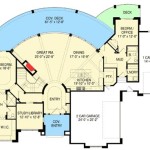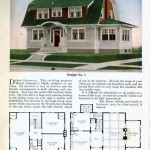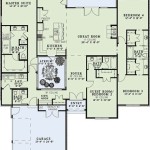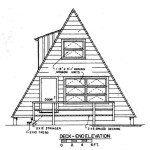Floor plans for a 3 bedroom 2 bath house outline the layout and design of a single-family home. They provide a visual representation of the home’s interior, including the arrangement of rooms, hallways, and other spaces.
These floor plans are essential tools for architects, builders, and homeowners alike. They help to ensure that the home is designed efficiently and meets the needs of its occupants. For instance, a well-designed floor plan can maximize natural light, create a sense of flow, and accommodate specific lifestyle requirements.
In the following sections, we will explore various floor plans for 3 bedroom 2 bath houses, discussing their advantages, disadvantages, and key features. Whether you’re building a new home or renovating an existing one, this guide will provide valuable insights to help you create a functional and stylish living space.
When considering floor plans for a 3 bedroom 2 bath house, there are several key points to keep in mind:
- Room layout:
- Flow and functionality:
- Natural light:
- Storage space:
- Outdoor access:
- Energy efficiency:
- Customization options:
- Budget considerations:
- Building codes:
- Personal preferences:
By carefully considering these factors, you can create a floor plan that meets your specific needs and creates a comfortable and stylish living space.
Room layout:
The room layout of a 3 bedroom 2 bath house is a crucial aspect of the floor plan, as it determines the functionality and livability of the space. Here are some key points to consider when planning the room layout:
- Master suite placement: The master suite is typically the largest and most private bedroom in the house, and it often includes a private bathroom and walk-in closet. It’s important to place the master suite in a quiet area of the house, away from high-traffic areas like the living room or kitchen.
- Secondary bedrooms: The secondary bedrooms should be placed near the master suite, but they should also have some separation to provide privacy for all occupants. It’s important to consider the size and shape of the secondary bedrooms, as well as the need for closet space and natural light.
- Bathroom placement: The main bathroom should be easily accessible from the secondary bedrooms, and it should be large enough to accommodate multiple users at once. The master bathroom should be private and luxurious, and it may include a separate shower and bathtub, as well as a double vanity.
- Common areas: The living room, dining room, and kitchen are the common areas of the house, and they should be designed to flow together seamlessly. The living room should be the largest of the common areas, and it should be placed in a central location. The dining room should be adjacent to the kitchen, and it should be large enough to accommodate a table and chairs for all occupants.
By carefully considering the room layout, you can create a floor plan that meets your specific needs and creates a comfortable and stylish living space.
Flow and functionality:
Flow and functionality refer to the way that people move through and use a space. A well-designed floor plan will create a smooth and efficient flow of traffic, while also providing functional spaces that meet the needs of the occupants.
- Clear circulation paths: The main circulation paths in a house should be wide and unobstructed, allowing people to move around easily without bumping into furniture or each other. This is especially important in areas like the kitchen and hallways.
- Defined spaces: Each room in the house should have a clear purpose and function. The living room should be designed for relaxation and entertainment, while the kitchen should be designed for cooking and dining. Avoid creating undefined spaces that don’t serve a specific purpose.
- Adequate storage: Every room in the house should have adequate storage space to keep belongings organized and out of sight. This includes closets in bedrooms, cabinets in the kitchen, and shelves in the living room.
- Natural light and ventilation: Natural light and ventilation are essential for creating a healthy and comfortable living environment. Floor plans should be designed to maximize natural light and ventilation throughout the house, while also providing privacy when necessary.
By carefully considering flow and functionality, you can create a floor plan that meets your specific needs and creates a comfortable and stylish living space.
Natural light:
Natural light is essential for creating a healthy and comfortable living environment. It can improve mood, boost energy levels, and reduce stress. When designing a floor plan for a 3 bedroom 2 bath house, it is important to maximize natural light throughout the home.
There are several ways to incorporate natural light into a floor plan. One way is to use large windows and skylights. Windows should be placed on all sides of the house, if possible, to allow for cross-ventilation and to provide views of the outdoors. Skylights can be used to bring light into dark areas of the house, such as hallways and bathrooms.
Another way to maximize natural light is to use open floor plans. Open floor plans allow light to flow freely throughout the house, creating a more spacious and airy feeling. Avoid using closed-off rooms and heavy curtains, as these can block out natural light.
Finally, it is important to consider the orientation of the house when designing a floor plan. The orientation of the house will determine how much sunlight the house receives throughout the day. In the Northern Hemisphere, houses that face south will receive the most sunlight. In the Southern Hemisphere, houses that face north will receive the most sunlight.
By carefully considering natural light when designing a floor plan, you can create a home that is bright, airy, and healthy.
Storage space:
Adequate storage space is essential for any home, but it is especially important in a 3 bedroom 2 bath house. With three bedrooms and two bathrooms, there is a lot of potential for clutter and disorganization. A well-designed floor plan will include plenty of storage space to keep belongings organized and out of sight.
There are several different types of storage space that can be incorporated into a floor plan. Closets are a classic storage solution, and they can be used in bedrooms, hallways, and other areas of the house. Cabinets are another great option for storage, and they can be used in the kitchen, bathroom, and other areas. Shelves are a versatile storage solution that can be used in any room of the house. They can be used to store books, dcor, and other items.
When planning storage space, it is important to consider the needs of the occupants. For example, a family with young children will need more storage space for toys and games than a couple without children. It is also important to consider the size and shape of the items that will be stored. For example, a closet that is designed to store bulky items like blankets and pillows will need to be larger than a closet that is designed to store clothes.
By carefully considering storage space when designing a floor plan, you can create a home that is organized and clutter-free. This will make it easier to find what you need, and it will also create a more comfortable and stylish living environment.
In addition to the types of storage space mentioned above, there are also several other creative storage solutions that can be incorporated into a floor plan. For example, built-in benches with storage underneath can be used in the entryway or mudroom to store shoes and other items. Ottomans with storage compartments can be used in the living room or family room to store blankets, pillows, and other items. Wall-mounted shelves can be used in any room of the house to store books, dcor, and other items.
Outdoor access:
Outdoor access is an important consideration for any home, but it is especially important for a 3 bedroom 2 bath house. With three bedrooms and two bathrooms, there is a lot of potential for occupants to want to spend time outdoors. A well-designed floor plan will include several different ways to access the outdoors, such as a patio, deck, or balcony.
One of the most popular ways to access the outdoors is through a patio. Patios are typically located on the ground level of the house, and they can be made of a variety of materials, such as concrete, brick, or pavers. Patios are a great place to relax and entertain guests, and they can also be used for grilling or dining outdoors.
Decks are another popular way to access the outdoors. Decks are typically located on the second level of the house, and they are made of wood or composite materials. Decks are a great place to enjoy the views, and they can also be used for grilling or dining outdoors. Decks typically require more maintenance than patios, but they can add a lot of value to a home.
Balconies are a third way to access the outdoors. Balconies are typically located on the second or third level of the house, and they are made of wood, metal, or concrete. Balconies are a great place to enjoy the views, and they can also be used for grilling or dining outdoors. Balconies typically require less maintenance than decks, but they can be more expensive to build.
When planning outdoor access, it is important to consider the needs of the occupants. For example, a family with young children will need a safe and secure way to access the outdoors. It is also important to consider the climate when planning outdoor access. For example, if you live in a climate with extreme weather conditions, you may want to consider building a covered patio or deck.
By carefully considering outdoor access when designing a floor plan, you can create a home that is both comfortable and stylish. This will make it easier to enjoy the outdoors, and it will also create a more inviting and welcoming home.
Energy efficiency:
Energy efficiency is an important consideration for any home, but it is especially important for a 3 bedroom 2 bath house. With three bedrooms and two bathrooms, there is a lot of potential for energy consumption. A well-designed floor plan can incorporate several features that will improve the energy efficiency of the home, such as:
- **Proper insulation:** Insulation is one of the most important factors in determining the energy efficiency of a home. Proper insulation will help to keep the home warm in the winter and cool in the summer, reducing the need for heating and cooling.
- **Energy-efficient windows and doors:** Windows and doors are another major source of energy loss in a home. Energy-efficient windows and doors are designed to minimize heat loss and gain, helping to keep the home more comfortable and reducing energy consumption.
- **ENERGY STAR appliances:** ENERGY STAR appliances are designed to be more energy-efficient than standard appliances. By choosing ENERGY STAR appliances, you can save money on your energy bills and reduce your environmental impact.
- **Proper ventilation:** Proper ventilation is important for maintaining a healthy indoor environment and for preventing moisture buildup, which can lead to mold and other problems. A well-designed floor plan will include features that promote proper ventilation, such as cross-ventilation and exhaust fans.
By incorporating these features into the floor plan, you can create a home that is more energy-efficient and comfortable. This will save you money on your energy bills and reduce your environmental impact.
In addition to the features mentioned above, there are several other ways to improve the energy efficiency of a 3 bedroom 2 bath house. For example, you can install a programmable thermostat to automatically adjust the temperature of the home, or you can install a solar water heater to reduce your reliance on fossil fuels. You can also make changes to your lifestyle to improve energy efficiency, such as turning off lights when you leave a room or unplugging appliances when you’re not using them.
Customization options:
Customization options allow you to tailor the floor plan of your 3 bedroom 2 bath house to your specific needs and preferences. There are many different ways to customize a floor plan, including:
- Room layout: The room layout is one of the most important aspects of a floor plan. You can customize the room layout to create a space that flows well and meets your specific needs. For example, you could create an open floor plan with a large living room and kitchen, or you could create a more traditional floor plan with separate rooms for the living room, dining room, and kitchen.
- Room size: You can also customize the size of the rooms in your house. For example, you could make the master bedroom larger and the secondary bedrooms smaller, or you could make all of the bedrooms the same size. The size of the rooms will depend on your specific needs and preferences.
- Finishes: The finishes in your house, such as the flooring, countertops, and cabinets, can also be customized. You can choose finishes that match your personal style and that complement the overall design of your home. For example, you could choose hardwood floors and granite countertops for a more traditional look, or you could choose tile floors and laminate countertops for a more modern look.
- Features: You can also add features to your home that meet your specific needs and preferences. For example, you could add a fireplace to the living room, a walk-in closet to the master bedroom, or a screened-in porch to the backyard. The features that you add to your home will depend on your specific lifestyle and preferences.
By customizing the floor plan of your 3 bedroom 2 bath house, you can create a space that is perfect for you and your family. You can choose the room layout, room size, finishes, and features that meet your specific needs and preferences. This will allow you to create a home that is both comfortable and stylish.
Budget considerations:
Budget considerations are an important factor to keep in mind when designing a floor plan for a 3 bedroom 2 bath house. The cost of building a home can vary significantly depending on the size of the house, the materials used, and the complexity of the design. It is important to create a budget before you start designing your home so that you can make informed decisions about the features and finishes that you can afford.
- Size of the house: The size of the house is one of the biggest factors that will affect the cost of construction. A larger house will require more materials and labor to build, which will increase the cost. It is important to choose a size that meets your needs and budget.
- Materials used: The materials used to build your home will also affect the cost. Some materials, such as brick and stone, are more expensive than others, such as vinyl and aluminum. It is important to choose materials that are durable and affordable.
- Complexity of the design: The complexity of the design will also affect the cost of construction. A simple design will be less expensive to build than a complex design. If you are on a tight budget, it is important to choose a simple design that meets your needs.
- Labor costs: The cost of labor will also vary depending on the location of your home. Labor costs are typically higher in urban areas than in rural areas. It is important to factor in the cost of labor when budgeting for your home.
By carefully considering budget considerations when designing a floor plan for a 3 bedroom 2 bath house, you can create a home that meets your needs and fits your budget. It is important to work with a qualified builder to ensure that your home is built to your specifications and within your budget.
Building codes:
Building codes are a set of regulations that govern the construction of buildings. These codes are in place to ensure that buildings are safe and habitable. Building codes are typically developed by local governments and may vary from one jurisdiction to another.
- Structural safety: Building codes ensure that buildings are structurally sound and can withstand the forces of nature, such as earthquakes, hurricanes, and tornadoes. Building codes specify the minimum requirements for the size and strength of structural elements, such as beams, columns, and walls.
- Fire safety: Building codes also include requirements for fire safety. These requirements are designed to prevent fires from starting and spreading, and to provide a safe means of escape in the event of a fire. Building codes specify the minimum requirements for fire-resistant materials, fire alarms, and sprinkler systems.
- Energy efficiency: Building codes also include requirements for energy efficiency. These requirements are designed to reduce the amount of energy used by buildings. Building codes specify the minimum requirements for insulation, windows, and doors. The goal is to create buildings that are more energy-efficient and environmentally friendly.
- Accessibility: Building codes also include requirements for accessibility. These requirements are designed to make buildings accessible to people with disabilities. Building codes specify the minimum requirements for ramps, elevators, and other accessibility features.
Building codes are an important part of the construction process. They help to ensure that buildings are safe, habitable, and accessible. When designing a floor plan for a 3 bedroom 2 bath house, it is important to comply with all applicable building codes.
Personal preferences:
Personal preferences play a significant role in designing a floor plan for a 3 bedroom 2 bath house. The layout, size, and features of the house should reflect the needs and desires of the occupants. Some of the key personal preferences that should be considered include:
- Lifestyle: The lifestyle of the occupants will have a major impact on the design of the floor plan. For example, a family with young children will need a floor plan that includes a playroom or family room, while a couple without children may prefer a more open floor plan with a large living room and kitchen. A person who works from home may favour a floor plan where one of the bedrooms is designed as a home office.
- Hobbies and interests: The hobbies and interests of the occupants should also be considered when designing the floor plan. For example, a person who loves to cook may want a kitchen with a large island and plenty of counter space, while a person who enjoys gardening may want a floor plan that includes a sunroom or greenhouse.
- Aesthetics: The aesthetics of the house are also important to consider. The occupants should choose a floor plan that reflects their personal style. For example, a person who prefers a traditional style may choose a floor plan with a formal living room and dining room, while a person who prefers a more modern style may choose a floor plan with an open concept design.
- Future needs: It is also important to consider future needs when designing the floor plan. For example, a couple who plans to have children in the future may want to choose a floor plan that includes a fourth bedroom. A person who plans to retire in the house may want to choose a floor plan that includes a first-floor master bedroom.
By considering personal preferences, you can create a floor plan for a 3 bedroom 2 bath house that is both functional and stylish. The house will be a reflection of your unique personality and lifestyle, and it will be a place where you can enjoy spending time with your family and friends.










Related Posts








